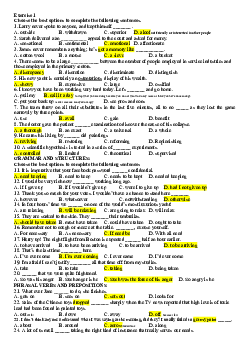

Preview text:
GUIDED CLOZE PRACTICE - 03
GUIDED CLOZE PRACTICE - 03
Read the following passages and decide which answer (A, B, C or D) best fits each gap. Passage 1:
KILLER WHALES GAIN ADORATION
People have been drawn to orcas in different places and (1) _______ for a variety of reasons. (2)
_______, when we knew relatively little about them, there was something very (3) _______ about
this black-and-white predator with wolf teeth appearing in the mist of the Northwest. But as we got
to know more about them, people came to (4) _______ what we’d call their family bonds. That
transformed (5) ________ of them. We tend to value animals that remind us of people, with
characteristics we imagine in ourselves. So people are fascinated by the orca’s family bonds,
especially their matrilineal units. It connects with people’s emotions and causes us to view them
differently than solitary predators, like great white sharks.
Both in captivity and in the wild, their (6) ________ are often tender and complex, which we
increasingly acknowledge as cultural interaction. The populations we have in the Northwest have
their itineraries and cultural practices. For example, northern residents have this whale spa in
Bight, where they go and rub themselves on these smooth pebbles right (7) _______ the beach.
This seems to be a regular practice with them, where they socialize.
Southern Residents have this (8) ________ ritual that they engage in when they encounter one
another. They line up (9) ________ straight lines when they see each other, 100 or 200 meters
apart, stop and wait for a moment, and then they engage in this mad (10) ________ of greeting,
which looks like they are meeting long-lost loved ones. 1. A. contexts B. background C. environment D. settings 2. A. Initially B. Firstly C. Primitively D. Previously 3. A. shocking B. imposing C. impressive D. striking 4. A. evaluate B. consider C. appreciate D. calculate 5. A. perceptions B. percentiles C. conceptions D. proportions 6. A. reactions B. interactions C. relationships D. relatives 7. A. off B. on C. into D. upon 8. A. eye-catching B. adorable C. breathtaking D. assiduous 9. A. on B. in C. aside D. up 10. A. abundance B. barnstorming C. bounce D. frolic Your answer: 1. 2. 3. 4. 5. 6. 7. 8. 9. 10.
Compiled by The English Hub for the Specialised Page 1 GUIDED CLOZE PRACTICE - 03 Passage 2:
MIDSUMMER NIGHT’S EVE
In Europe, Midsummer Night’s Eve, also known as St John’s Eve, occurs on June 23rd. It
originates from the pagan celebrations of the summer solstice which were held on June 21st. On
that night throughout Europe bonfires were lit along hillsides to (1) ________ the shortest night of
the year. It must have looked as if some kind of violent insurrection was taking place down the
coast of Scotland and England, but these signal fires in fact had a very important purpose. Bones
of farm animals (2) ________ the previous autumn were burned and, when the fires had gone out,
the remaining ash was put to good use: it was spread on the fields to enrich the land and (3)
________ a good harvest. The word ‘bonfire’ is (4) ________ from ‘bone fire’.
In Brazil too St John’s Eve means bonfires and fireworks. Another quaint tradition involves the (5)
_________ of small paper hot-air balloons, although they are prohibited by the law in the cities
because of the fire (6) _________. Bonfires mark the beginning of spring rather than the summer in
Sweden and are lit on the last night of April. In the Swedish Midsummer’s Eve ceremony, held on
June 24th, a large pole, decorated with flowers and leaves, is placed in the ground. Thistles also
have a (7) ________ role in the celebration of Midsummer’s Night Eve in Europe. In the past they
were thought to (8) ________ witches. The pretty, prickly plant was nailed over barn doors and
used in wreaths, the circular shape being a (9) ________ of the turning of the seasons. Wheels
laced with straw and soaked in pitch were lit from the bonfires and then roiled down hills. There is
less risk of fire in a tradition common to many Slavic countries. Young women and girls float little
baskets of flowers and lighted candles down the streams. Local boys swim out to (10) ________ a
basket, find a girls it belongs to and claim a dance at the town’s Midsummer’s Eve Party. 1. A. celebrate B. honour C. commemorate D. commiserate 2. A. revived B. assassinated C. slaughtered D. sacrificed 3. A. assure B. safeguard C. ensure D. endanger 4. A. derived B. developed C. evolved D. decayed 5. A. landing B. launching C. propelling D. ejecting 6. A. certainty B. peril C. jeopardy D . hazard 7. A. decisive B. serious C. trivival D. significant 8. A. deflect B. ward off C. attract D. avert 9. A. sign B. password C. logo D. symbol 10. A. salvage B. rescue C. set free D. liberate Your answer: 1. 2. 3. 4. 5. 6. 7. 8. 9. 10.
Compiled by The English Hub for the Specialised Page 2



